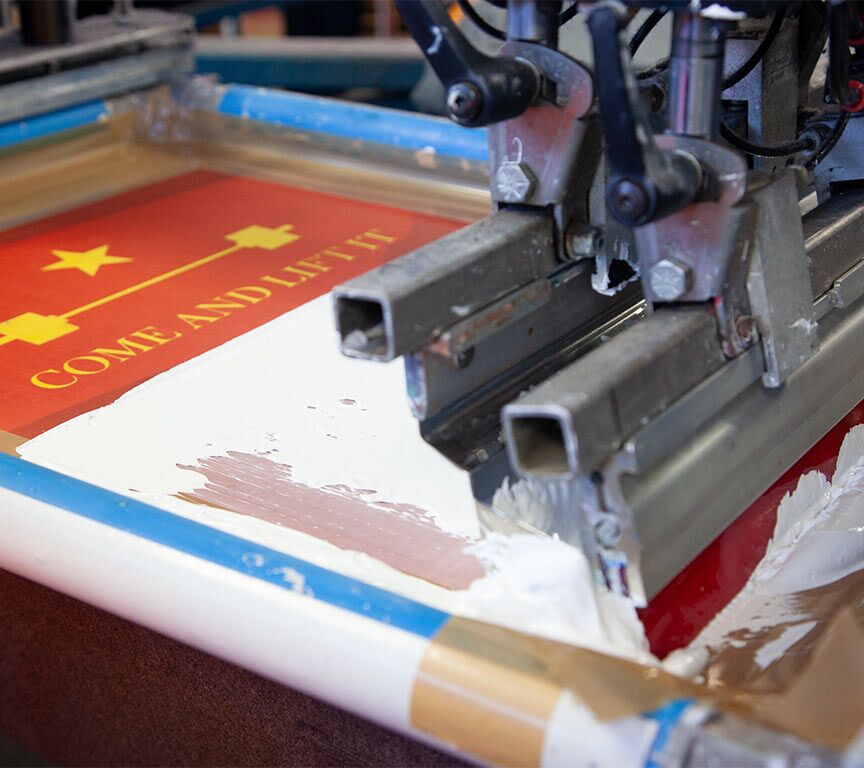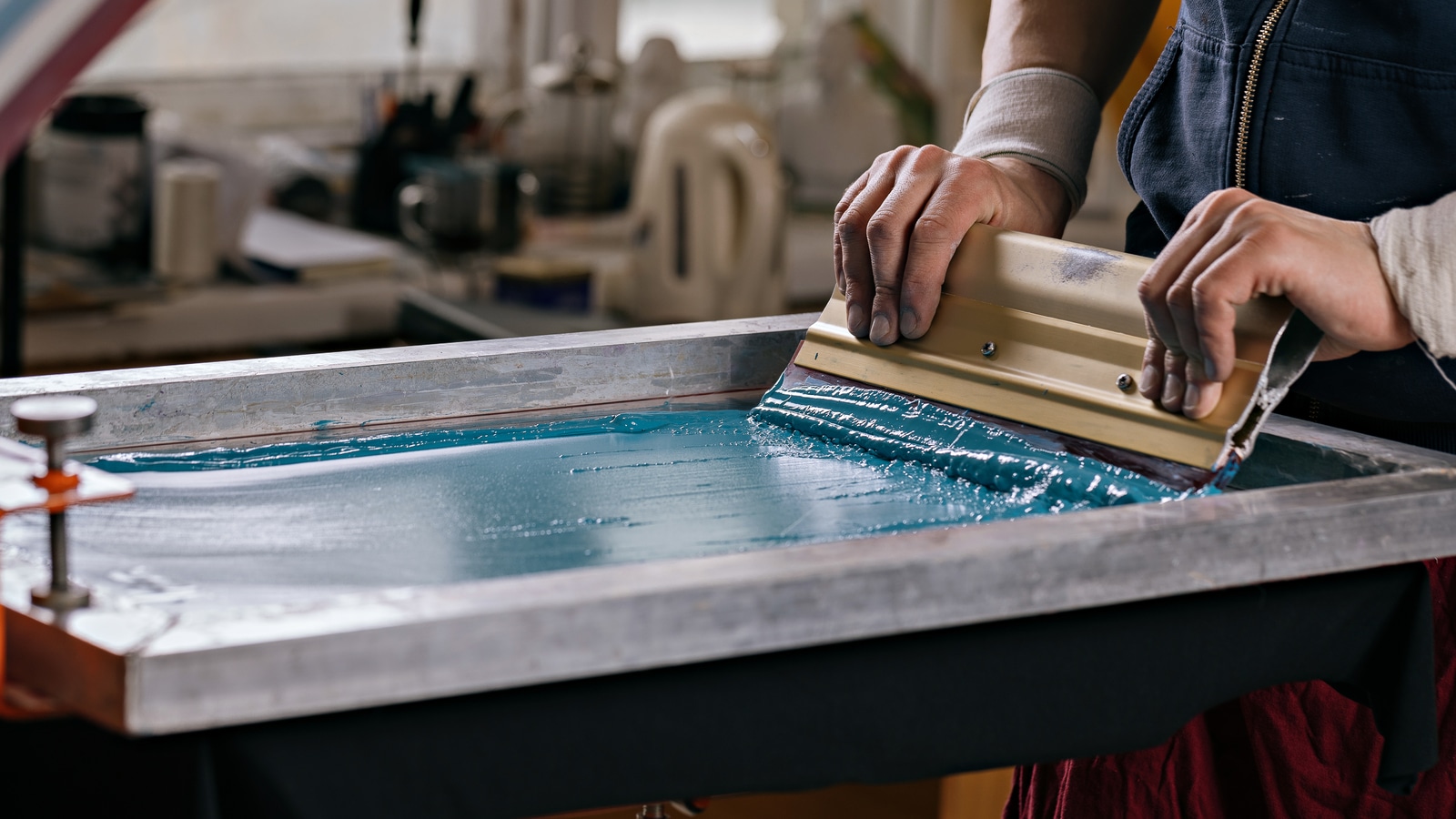Artistic Silk Screen Printing for Limited Edition Prints
Artistic Silk Screen Printing for Limited Edition Prints
Blog Article
Screen Printing Uncovered: Whatever You Need to Understand About T-Shirt and Garment Printing Strategies
If you have actually ever wondered how those vibrant styles end up on your preferred tee shirts, you're in the appropriate place. Display printing is a fascinating approach that combines art with method, providing unlimited possibilities for creative thinking. Understanding the principles, from tools to ink selections, can significantly influence your results. All set to check out the essential components that make display printing an art form? Allow's discover the information that can raise your projects.
The Basics of Display Printing: How It Works
When you dive right into screen printing, you'll uncover it's both a scientific research and an art. At its core, display printing includes creating a stencil, or display, that allows ink to pass via just in details areas.
Next, you'll blend your inks and prepare your printing surface area. Position the screen over the textile, after that use a squeegee to press ink via the screen onto the garment. This procedure requires precision, as you desire clear, vibrant prints. After printing, you'll cure the ink with warmth, ensuring it complies with the textile and lasts via washes. Each action is crucial, and mastering them will certainly boost your display printing skills, transforming basic garments right into distinct, meaningful items.
Types of Screen Printing Methods
Once you understand the basics of display printing, it's time to check out the different methods that can raise your designs. One popular approach is standard display printing, where ink is pressed with a stenciled screen.
If you're aiming for fine details, consider discharge printing. This technique gets rid of dye from the fabric, leaving a soft, classic appearance. Another choice is plastisol printing, recognized for its durability and dazzling colors, making it a preferred for lots of brands. Finally, trying out halftone printing to produce gradient effects and elaborate designs. Each method has its unique charm, so do not wait to try them bent on discover what suits your style best!
Important Tools for Screen Printing
To accomplish stunning cause display printing, having the best tools is fundamental. You'll require a sturdy screen printing framework, which holds the mesh that moves your design onto the garment. Next off, spend in top quality squeegees; these are crucial for applying ink equally across the screen. You'll additionally require a good exposure system to create your screens, in addition to a washout cubicle for cleansing them after usage. A dependable warm source, like a conveyor clothes dryer or warm press, is crucial for healing your prints to assure long life. Do not neglect an appropriate workspace, geared up with tables and storage for your supplies. Protective gear, such as gloves and masks, will maintain you secure from chemicals and inks. With the right devices, you'll be well on your means to generating professional-quality prints.
Picking the Right Inks and Products
When selecting inks and products for screen printing, you require to take right into account the sort of ink that functions finest for your job. Think concerning textile compatibility to ensure your designs look fantastic and last long. Check out eco-friendly ink alternatives to make your printing procedure much more sustainable.
Kinds Of Screen Inks
Picking the appropriate screen ink is important for attaining lively, durable prints that fulfill your job's demands. There are a number of types of display inks to take a look at. Plastisol ink is prominent for its flexibility and ease of usage, supplying excellent shade opacity on dark fabrics. Water-based ink, on the other hand, offers a softer feeling and is environmentally friendly, making it ideal for those aiming to reduce their environmental influence. Discharge inks eliminate color from the fabric, causing a soft, vintage appearance yet require certain handling. Specialized inks, such as metal or glow-in-the-dark, can include one-of-a-kind effects to your styles. Evaluate your project needs and select the ink that lines up finest with your wanted end result.

Fabric Compatibility Factors To Consider
Comprehending fabric compatibility is crucial for achieving high-quality screen prints, especially considering that different materials respond distinctively to various inks. Always examine your inks on sample material to ensure they stick correctly and preserve color integrity. In addition, keep in mind that material weight and structure can influence the last outcome, so choosing the appropriate ink and product combination is important for your job's success.
Eco-Friendly Ink Options
Environment-friendly inks are coming to be a preferred option for screen printers that desire to decrease their ecological influence while maintaining quality. When picking inks, consider water-based inks, which are much less damaging and much easier to clean up compared to conventional solvents.
Additionally, search for inks made from sustainable resources, such as soy or vegetable-based choices. By choosing the right inks and materials, you'll not only develop magnificent layouts however likewise add to a more sustainable printing procedure. Make the switch, and your prints will certainly mirror your commitment to the atmosphere!
Preparing Your Layout for Display Printing

File Style Needs
To guarantee your layout looks lively and sharp on textile, you'll need to pay attention to file style needs for display printing. Begin with vector documents like AI or EPS, as they can be scaled without shedding high quality. If you utilize raster photos, select high-resolution documents, such as TIFF or PNG, ideally at 300 DPI. Avoid using JPEGs, as they can lose clearness when resized. Also, see to it your style has a clear history to avoid unwanted white edges on your prints. Keep shade settings in mind; CMYK is common for display printing, so transform your RGB develops appropriately - screen printing kit. By complying with these standards, you'll establish your art work up for a successful print.
Shade Splitting Up Methods
Color separation is an essential step in preparing your layout for display printing, and grasping it can considerably enhance your print quality. You'll need to break your layout right into specific shades, as each color needs a separate display during printing. Beginning by recognizing all the shades in your style and create layers each. You can make use of software program like Adobe Photoshop or Illustrator to isolate and separate shades successfully. Be specific to conserve each layer as a separate file, typically in a layout like TIFF or PSD. This precision not only ensures exact shade representation yet likewise improves the printing procedure. By taking notice of color splitting up, you'll attain dynamic and specialist lead to your screen-printed garments.
Resolution and Size
Attaining the very best cause display printing starts with assuring your style has the appropriate resolution and size. Preferably, your art work should go to the very least 300 DPI (dots per inch) for sharp, clear prints. Your last item might look pixelated and unprofessional. if you make use of lower resolution.
When it pertains to dimension, take into consideration the measurements of your print location. Design your artwork to match the final print size, ideally developing it in the real dimensions you'll be printing. By doing this, you'll prevent any kind of unforeseen scaling concerns.
Constantly examine your design in both vector and raster formats. Vector graphics can be scaled without shedding quality, making them optimal for display printing. Preparing appropriately will assure your design looks outstanding on every garment!
Step-by-Step Display Printing Refine
Screen printing is a vibrant procedure that enables you to develop lively styles on various surfaces. To obtain begun, you'll require a display, emulsion, and your chosen ink.
After rinsing the unexposed solution, your display prepares. Set it up on your printing surface and straighten your garment under it. Put ink onto the display and use a squeegee to press the ink with the stencil onto the fabric. Raise the screen very carefully and let the print completely dry. Heal the ink utilizing warm to assure toughness. That's it! You've successfully display printed your design.
Tips for Effective Display Printing Projects
While you're diving into your screen printing projects, keep in mind that preparation is crucial to success. Start by gathering all your products-- inks, mops, garments, and screens. A tidy office aids protect against unwanted mistakes, so clean before you start.
Next, verify your artwork is high-resolution and correctly sized for your garment. Evaluate your display for correct exposure and clean it extensively to avoid spots. When blending your inks, follow the supplier's guidelines to attain the best consistency.
Throughout printing, apply even stress with your squeegee for consistent results. Don't hurry; take your time to validate each print meets your standards. After printing, let your garments completely dry totally prior to dealing with or packaging them.
Finally, constantly keep an example of your job for future reference. In this manner, you can examine your development and improve your methods gradually. Satisfied printing!

Regularly Asked Questions
How much time Does It Take to Set up a Display Printing Task?
Establishing a screen printing job generally takes about 30 mins to an hour. You'll prepare the displays, mix inks, and readjust journalism. The moment varies based on intricacy and experience, so remain organized!
Can I Print on Various Material Types Using the Very Same Technique?
Yes, you can print on various material types making use of the very same strategy, yet you'll need to adjust your inks and setups. Some textiles absorb ink in a different way, so exploring assurances the very best results for each and every material.
What Are Typical Blunders to Avoid in Display Printing?
When display printing, avoid typical blunders like utilizing the incorrect ink, ignoring proper direct exposure times, or avoiding pre-press checks. Always test your arrangement and keep tidy displays to guarantee high quality outcomes each time.
Exactly How Can I Effectively Clean and Preserve My Screen Printing Tools?
To effectively tidy and keep your display printing equipment, you ought to frequently wash screens with proper solvents, inspect squeegees for wear, and assure all tools are saved dry and dust-free. Uniformity improves and protects against pricey repair services efficiency.
Is Screen Printing Eco-friendly Compared to Other Methods?
Display printing can be a lot more ecologically pleasant than various other methods, specifically if you utilize eco-conscious materials and water-based inks. By choosing sustainable products and practices, you minimize waste and decrease your effect on the world.
Screen Printing Uncovered: Whatever You Required to Know garment printing Regarding Tee and Garment Printing Techniques
At its core, screen printing entails producing a stencil, or screen, that permits ink to pass with only in certain locations. Setting the screen over the fabric, after that use a squeegee to press ink through the display onto the garment. One preferred technique is traditional screen printing, where ink is pressed via a stenciled display.When picking inks and materials for display printing, you require to take right into account the kind of ink that works best for your task.
Report this page